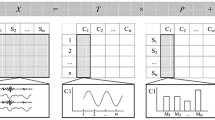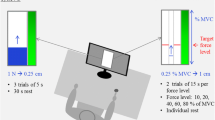Abstract
By analysis of parameters of isometric force recorded in healthy subjects from different age groups, amplitude and frequency changes in the integrated activity of motor system structures were shown to depend on voluntarily maintained isometric effort and its duration.
Similar content being viewed by others
References
Bracewell, R.M., Balasubramaniam, R., and Wing, A.M., Interlimb Coordination Deficits during Cyclic Movements in Cerebellar Hemiataxia, Neurology, 2005, vol. 64, no. 4, p. 751.
Ustinova, K.L., Goussev, V.M., Balasubramanian, R., and Leven, M.F., Disruption of Coordination between Arm, Trunk, and Center of Pressure Displacement in Patients with Hemiparesis, Motor Control, 2004, vol. 8, no. 2, p. 139.
Balasubramanian, R. and Turvey, M.T., Coordination Modes in the Multisegmental Dynamics of Hula Hooping, Biol. Cybern., 2004, vol. 9, no. 3, p. 176.
Hadders-Algra, M., The Neuromotor Examination of the Preschool Child and Its Prognostic Significance, Ment. Retard. Dev. Disabil. Res. Rev., 2005, vol. 11, no. 3, p. 180.
Hadders-Algra, M., General Movements: A Window for Early Identification of Children at High Risk for Developmental Disorders, J. Pediatr., 2004, vol. 145, no. 2, suppl., p. 12.
Lundervold, D.A. and Poppen, R., Biobehavioral Intervention for Older Adults Coping with Essential Tremor, Appl. Psychophysiol. Biofeedback, 2004, vol. 29, no. 1, p. 63.
Chung, W., Poppen, R., and Lundervold, D.A., Behavioral Relaxation Training for Tremor Disorders in Older Adults, Biofeedback Self-Regulation, 1995, vol. 20, no. 2, p. 123.
Duval, C., Panisset, M., and Sadikot, A.F., The Relationship between Physiological Tremor and the Performance of Rapid Alternating Movements in Healthy Elderly Subjects, Exp. Brain Res., 2001, vol. 139, no. 4, p. 412.
Rektor, I., Bares, M., Brazdil, M., et al., Cognitive-and Movement-Related Potentials Recorded in the Human Basal Ganglia, Mov. Disord., 2005, vol. 20, no. 5, p. 562.
Gurfinkel’, V.S., N.A. Bernstein and Modern Physiology of Motor Control (On His 100th Birthday), Fiziol. Chel., 1996, vol. 22, no. 6, p. 124 [Hum. Physiol. (Engl. Transl.), 1996, vol. 22, no. 6, p. 751].
Chabran, E., Maton, B., Ribreau, C., and Fourment, A., Electromyographic and Biomechanical Characteristics of Segmental Postural Adjustments Associated with Voluntary Wrist Movements. Influence of an Elbow Support, Exp. Brain Res., 2001, vol. 141, p. 133.
Stuart, D.G., Integration of Posture and Movement: Contributions of Sherrington, Hess, and Bernstein, Hum. Mov. Sci., 2005, vol. 24, no. 5–6, p. 621.
Hooper, S.L., Movement Control: Dedicated or Distributed, Current Biology, 2005, vol. 15, no. 21, p. R878.
Hooper, S.L. and Weaver, A.L., Motoneuron Activity Is Often Insufficient to Predict Motor Response, Curr. Opin. Neurobiol., 2000, vol. 10, no. 6, p. 676.
Holdefer, R.N. and Miller, L.E., Primary Motor Cortical Neurons Encode Functional Muscle Synergies, Exp. Brain Res, 2002, vol. 146, no. 2, p. 233.
Kagerer, F.A., Summers, J.J., and Semjen, A., Instabilities during Antiphase Bimanual Movements: Are Ipsilateral Pathways Involved, Exp. Brain Res., 2003, vol. 151, p. 489.
Yazawa, S., Ikeda, A., Kunieda, T., et al., Human Presupplementary Motor Area Is Active before Voluntary Movement: Subdural Recording of Bereitschaftspotential from Medial Frontal Cortex, Exp. Brain Res., 2000, vol. 131, p. 165.
Ishihara, A., Roy, R.R., Ohira, Y., and Edgerton, V.R., Motoneuron and Sensory Neuron Plasticity to Varying Neuromuscular Activity Levels, Exerc. Sport Sci. Rev., 2003, vol. 31, no. 1, p. 51.
Enoka, R.M. and Fuglevand, A.J., Motor Unit Physiology: Some Unresolved Issues, Muscle Nerve, 2001, vol. 24, no. 1, p. 4.
Kalff, A.C., de Sonneville, L.M., Hurks, P.P., et al., Low-and High-Level Controlled Processing in Executive Motor Control Tasks in 5–6-Year-Old Children at Risk of ADHD, J. Child Psychol. Psychiatry, 2003, vol. 44, no. 7, p. 1049.
Kernell, D., Principles of Force Gradation in Skeletal Muscles, Neural Plast., 2003, vol. 10, nos. 1–2, p. 69.
Neilson, P.D. and Neilson, M.D., Motor Maps and Synergies, Hum. Mov. Sci., 2005, vol. 24, nos. 5–6, p. 774.
Decety, J., Chaminade, T., Grezes, J., and Meltzoff, A.N., A PET Exploration of the Neural Mechanisms Involved in Reciprocal Imitation, Neuroimage, 2002, vol. 15, no. 1, p. 265.
Rumiati, R.I., Weiss, P.H., Tessari, A., et al., Common and Differential Neural Mechanisms Supporting Imitation of Meaningful and Meaningless Actions, J. Cogn. Neurosci., 2005, vol. 17, no. 9, p. 1420.
Park, J.H. and Stelmach, G.E., Effect of Combined Variation of Force Amplitude and Rate of Force Development on the Modulation Characteristics of Muscle Activation during Rapid Isometric Aiming Force Production, Exp. Brain Res., 2006, vol. 168, no. 3, p. 337.
Hwang, I.S. and Cho, C.Y., Muscle Control Associated with Isometric Contraction in Different Joint Positions, Electromyogr. Clin. Neurophysiol., 2004, vol. 44, no. 8, p. 463.
Bazzucchi, I., Marchetti, M., Rosponi, A., et al., Differences in the Force/Endurance Relationship between Young and Older Men, Eur. J. Appl. Physiol., 2005, vol. 93, no. 4, p. 390.
Sbriccoli, P., Bazzucchi, I., Rosponi, A., et al., Amplitude and Spectral Characteristics of Biceps Brachii sEMG Depend upon Speed of Isometric Force Generation, J. Electromyogr. Kinesiol., 2003, vol. 13, no. 2, p. 139.
Kalmar, J.M. and Cafarelli, E., Central Excitability Does Not Limit Postfatigue Voluntary Activation of Quadriceps Femoris, J. Appl. Physiol., 2006, vol. 100, no. 6, p. 1757.
Schwid, S.R., Thornton, C.A., Pandya, S., et al., Quantitative Assessment of Motor Fatigue and Strength in MS, Neurology, 1999, vol. 53, no. 4, p. 743.
Sanjak, M., Konopacki, R., Capasso, R., et al., Dissociation between Mechanical and Myoelectrical Manifestation of Muscle Fatigue in Amyotrophic Lateral Sclerosis, Amyotroph. Lat. Scler. Other Motoneuron Disord., 2004, vol. 5, no. 1, p. 26.
Georgopoulos, A.P., News in Motor Control Physiology, News Physiol. Sci., 1999, vol. 14, p. 64.
Georgopoulos, A.P., Ashe, J., Smyrnis, N., and Taira, M., Motor Cortex and the Coding of Force, Science, 1992, vol. 256, p. 1692.
Evarts, E.V., Brain Mechanisms of Movement, Vestn. Leningr. Univ., 1974, no. 21, p. 88.
Evarts, E.V., Brain Mechanisms Responsible for Movement, in Mozg (Brain), Simonov, P.V., Ed., Moscow: Mir, 1982, p. 199.
Evarts, E.V. and Wise, Basal Ganglia Outputs and Motor Control, Ciba Found Symp., 1984, vol. 107, p. 83.
Romanov, S.P., Aleksanyan, Z.A., and Manoilov, V.V., Characteristics of Tremor in Normal Subjects and in the Diagnosis and Treatment of Parkinsonism, Ross. Fiziol. Zh. Im. I.M. Sechenova, 2002, vol. 88, no. 10, p. 1356.
Kozarov, D. and Shapkov, Yu.T., Dvigatel’nye edinitsy skeletnykh myshtz cheloveka (Motor Units of Human Skeletal Muscles), Leningrad: Nauka, 1983.
Romanov, S.P., Inhibitory Feedback in Regulatory Circuit of Motoneuron Discharges, Fiziol. Zh. Im. I.M. Sechenova, 1996, vol. 82, no. 1, p. 33.
Elbe, R.J., Central Mechanisms of Tremor, J. Clin. Neurophysiol., 1996, vol. 13, no. 2, p. 133.
Elbe, R.J. and Koller, W.C., Tremor, Baltimore: Johns Hopkins Univ., 1990.
Kryzhanovskii, G.N., Karaban’, I.N., Magaeva, S.V., et al., Bolezn’ Parkinsona: etiologiya, patogenez, klinika, diagnostikaa, lechenie, profilaktika (Parkinson’s Disease: Ethiology, Pathogenesis, Clinic, Diagnostics, Treatment, and Prevention), Moscow: Meditsina, 2002.
McAuley, J.H., Rothwell, J.C., and Mardsen, C.D., Frequency Peaks of Tremor, Muscle Vibration, and Electromyographic Activity at 10 Hz, 20 Hz, and 40 Hz during Human Finger Muscle Contraction May Reflect Rhythmicities of Central Neural Firing, Exp. Brain Res., 1997, vol. 114, p. 525.
Shapkov, Yu.T., Anisimova, N.P., Gerasimenko, Yu.P., and Romanov, S.P., Regulyatsiya sledyashchikh dvizhenii (Regulation of Tracking Movements), Leningrad: Nauka, 1988.
Author information
Authors and Affiliations
Additional information
Original Russian Text © S.P. Romanov, Z.A. Aleksanyan, E.B. Lyskov, 2007, published in Fiziologiya Cheloveka, 2007, Vol. 33, No. 4, pp. 82–94.
Rights and permissions
About this article
Cite this article
Romanov, S.P., Aleksanyan, Z.A. & Lyskov, E.B. Age-related changes in the activity of the human motor system. Hum Physiol 33, 455–466 (2007). https://doi.org/10.1134/S0362119707040123
Received:
Issue Date:
DOI: https://doi.org/10.1134/S0362119707040123




